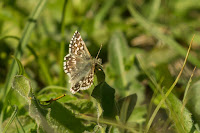 |
| Wood Anemones - pink ones!
©
Angela Morrell
|
 |
| Brown-banded Carder Bee
©
Chris Robinson
|
A record 23
members joined Angela for a Bluebell walk in Roydon Woods. The woods were
looking lovely, fresh new green leaves, mainly of Beech, Oak and Hazel, were
coming out every-where in different shades of green.
Besides the carpets of
Bluebells we saw many woodland spring flowers including Wood Spurge, Greater
Stitchwort, Yellow Pimpernel, Common Dog-violet, Common Figwort, Dogs’ Mercury,
Ladies’ Smock, Herb Robert, Kingcups, Bugle, Barren Strawberry, Pignut and a
Common Spotted Orchid, not yet in flower. Wood Anemones were still flowering,
including some clumps of the less common pink variety.
 |
| Speckled Wood
©
Chris Robinson
|
 |
| Wild Service Tree
©
Chris Robinson
|
The damp
woods are a good place to find ferns; Scaly Male Fern, Hard Fern, Broad Buckler
and Hartstongue. The sunshine brought out the bees and butterflies: Brown-banded Carder Bee Small and Green-veined
Whites, Speckled Wood, Brimstone, and Orange Tip.
Some seedling trees attracted
our attention at the end of the walk. We identified these as Wild Service Trees,
an unusual native tree that can be found locally in the Forest. A slime mould Fuligo septica was also discovered
which is called 'Flowers of Tan' due to its regular appearance on the bark used
in tanning. (AM)
 |
| Fuligo septica
©
Chris Robinson
|













